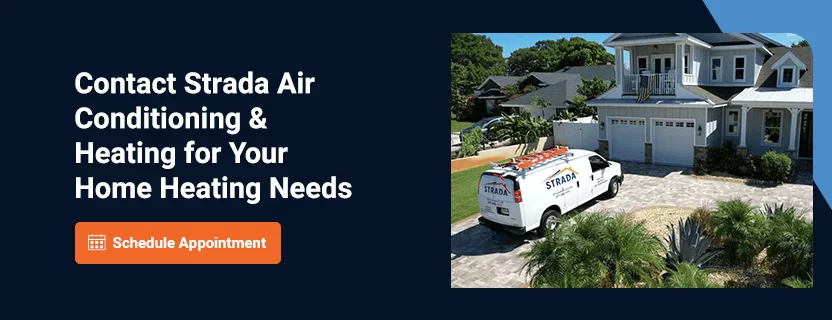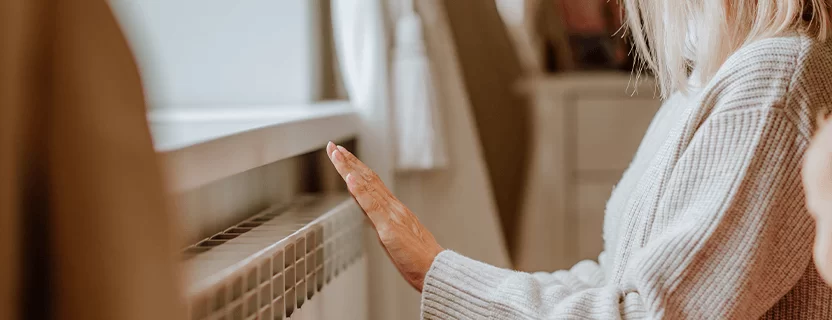
Some people love cooler Florida days for the opportunities they bring to snuggle and wrap up in warm, cozy blankets. Others miss the sunshine and aren’t fans of the cold that comes with its absence. Either way, being at home on cooler days prompts most of us to crank up the heat. One thing’s for sure: Just like you can add layers of clothing to keep warm when you go outside in the cold, there are multiple measures you can put in place to keep your home warm inside.
We’ve listed a few ways to keep your home warm during the colder days, which we hope will help you combat chilly mornings, afternoons evenings.
In Florida, temperatures don’t usually drop below 50-60 degrees Fahrenheit. However, going from 80 degrees to 55 degrees is still quite a jump and could make you crave the heat — especially if you work from home. Keeping warm while working from home helps you stay healthy and fit to perform your duties.
Living in a warm home can also come with some health benefits. A cold home can increase colds, coughs, and symptoms of asthma and other respiratory conditions. While this may not be as apparent in a warm state like Florida, we still have those chilly days.
And the comfort of a warm home shouldn’t be taken for granted either! You and your family or guests can feel cozy in a home that’s heated on cool days.
Before learning about how to keep your home warm, explore these tips for keeping yourself warm:
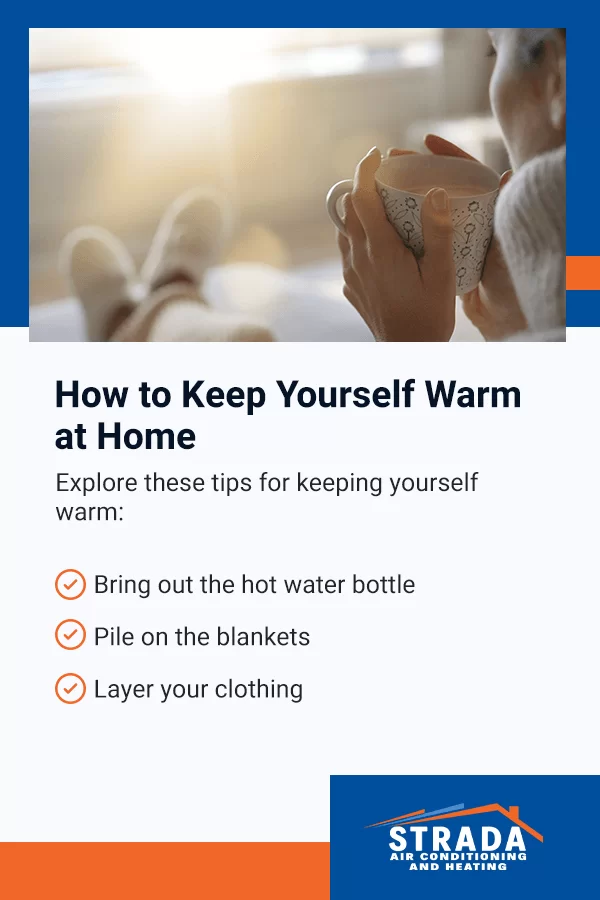
After employing these tips, you can take things a step further by working to heat your entire home.
There are numerous ways to keep your home warmer during the colder months. Here are a few ideas.
It might not be the quickest or cheapest option, but insulating your home’s interior can help you keep it warm while reducing energy bills in the long run since you’re likely using the HVAC less.
The walls are a good place to start, as they can trap and emit heat and cold as the weather changes. Plus, insulating your walls helps regulate temperatures throughout your home so that one room is not colder than another.
You can also insulate windows to keep heat inside and reduce the chances of cold air passing through cracks in the windows and doors. If you notice drafts coming through small gaps in your windows, insulation can definitely help. Caulking the windows is a quick and affordable way to prevent these drafts from coming through.
Your home can also lose heat through the floor, making it worthwhile to insulate if you want to keep your home warm and increase your energy savings.
There are a few more benefits to insulating your home, including:
Spray foam insulation is generally the most cost-effective option, but you’ll want to explore the various options available to you.
If you’ve left your radiator unused throughout the summer, you should check that the elements are still working and bleed the radiator if necessary. The following signs may mean you need to bleed your radiator:
The air that builds up in your heating system over time causes these issues, which can be resolved by bleeding the radiator. It’s easy — you just need a bleed key and an old cloth or a small jug. Then follow these steps:
This is a quick way to check that your radiator is ready to work so you’re equipped to keep your home warm during the cooler months, but be sure to check with a qualified installer if you find yourself needing to bleed it more frequently or if you notice other issues.
One small tip we can suggest is to secure foil against the wall behind the radiator. This will keep the heat from being absorbed by the wall and reflect into the room to be distributed instead.
If you don’t have a radiator but have a flat heat panel that’s fixed against the wall(s), check that it’s in working condition and emitting enough heat. It should never be covered completely, as this could lead to malfunction.
If you own a fireplace, you can take advantage of the natural heat of the fire to create an ambiance that everyone enjoys. Inspecting your fireplace before using it is a good idea if it hasn’t been used in a while. Here are a few things to remember:
While a fireplace may keep your home warm this season, you could end up spending a lot of money on wood and time on cleaning up. To combat this, consider investing in fireplace plugs or flue blockers that will help reduce drafts in summer when it’s not in use. Also, remember that electric fireplaces are much more efficient than wood-burning fireplaces.
A smart thermostat is a great investment since it can be programmed to regulate or change the temperature in your home at different times of the day. All you need to control the thermostat is a mobile app and a stable Wi-Fi connection. You can also integrate the thermostat into your smart home system and control it with your voice.
Smart thermostats can be set up to increase and decrease the temperature based on humidity, light and temperature, whether occupants are inside the home or not. This is especially convenient when you’re looking forward to being greeted by a warm home after a day out in the cold.
If you have a normal thermostat, lowering the temperature when you’re away from home can help you save on heating bills.
Radiators are an older home heating method that is safe and effective. Steam radiators use electricity or natural gas to convert water into steam. This creates heat that slowly emits through the iron bars, spreading consistently throughout the home. Electric radiators also use electricity to heat up mineral oil to generate heat through the radiator.
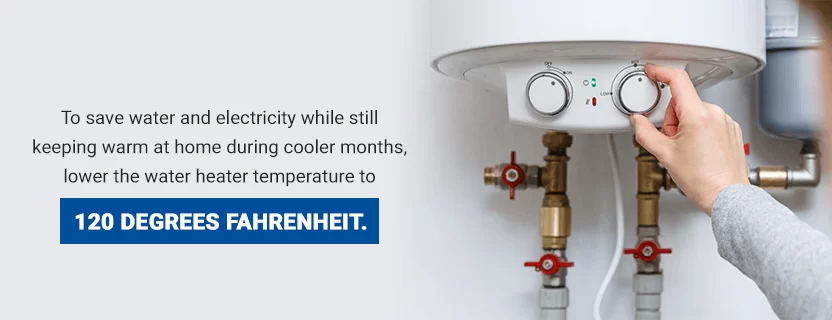
To save water and electricity while still keeping warm at home during cooler months, lower the water heater temperature to 120 degrees Fahrenheit. We also recommend taking showers instead of baths on chilly days, as the steam from the shower will help disperse warm air throughout your home once you’re done. You’ll also save on water and electricity by taking showers instead of baths.
Caulking your windows can help prevent drafts from entering, and the same is true of your doors. Add door sweeps that will keep the cold air from seeping through the gap beneath the door.
Additionally, if you have pets who use doggy or cat doors, you might want to seal them in anticipation of cooler days to prevent cold air from passing through. It’s not ideal if your pets are used to using the doors, but it will keep your home warm even on the coldest days. It’s an extra measure that could also help you save on energy bills since your heating system won’t have to work harder to keep your home warm.
Check your furnace filter regularly and replace it if it’s dirty. This often resolves heating issues you could be experiencing with your central heating system.
Your furniture could be blocking vents and radiators, preventing heat from circulating in your home. For example, placing your couch in front of your radiator could trap heat in one area, so moving it allows the heat to be distributed better. You can close the door if you want the heat confined to one area.
If you have hardwood floors, placing a rug or two across them will help keep your home warm. They feel soft and protect your feet from otherwise cold and hard floors. Plus, rugs add a lot of aesthetic value to your home, and you can move them around for added convenience.
Even cool days can come with sun — so take advantage of them. Open your blinds, curtains or drapes to let the natural light flood in and warm your home. You’ll benefit from the burst of vitamin D, and you won’t have to rely on your HVAC as heavily, which will help lower your utility bills.
Close up your drapes to retain heat and warm air when the sun goes down or disappears. Heavier drapes retain heat better, but you can go back to your lighter drapes in the summer!
Some ceiling fans have a setting you can use on cold days to reverse the rotation of the blades. This slow movement will push air downward to promote warmer airflow. Remember to go back to the summer setting when the temperatures rise again in the spring.
Your air ducts have dampers that allow air to flow based on the seasons, which can be adjusted accordingly. Check to see if there are handles on the dampers that can be set to regulate the airflow on cold days so it’s not as strong or cold.
There are many creative ways to keep your home warm using heat sources from inside your home. Here are a few examples:
These aren’t long-lasting ways to keep your home warmer, but you can use them to your advantage whenever you bake or take a shower.
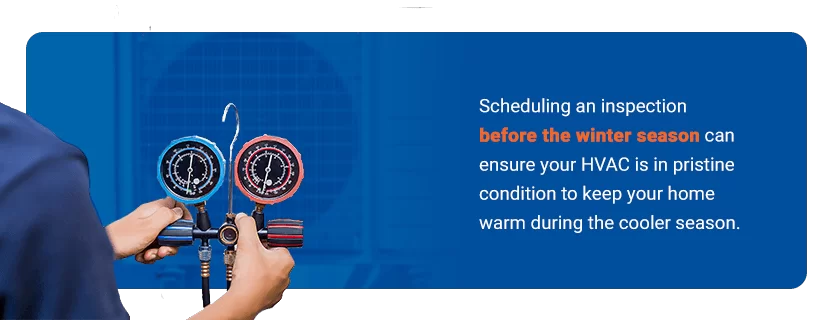
Your HVAC system works hard to keep your home cool on warm days and warm on cool days. There’s added pressure on exceptionally hot or cold days, which is why it helps to have your system checked out and maintained regularly. Scheduling an inspection before the winter season can ensure your HVAC is in pristine condition to keep your home warm during the cooler season.
Strada Air Conditioning & Heating is ready to assist you with your heat pump-related issues or needs. We offer preventive and full maintenance services to ensure you get the most out of your heating components.
If your system needs work, call us. Whether you need a new HVAC system or simple maintenance, we have the tools and experience to make it happen. Our technicians are highly skilled and extremely professional when it comes to delivering the best service in your area, so you’re always left completely satisfied.
We want to help you get your home ready so you’re warm and comfortable even on those chilly Florida days. Schedule an appointment today, or request more information about our services!
